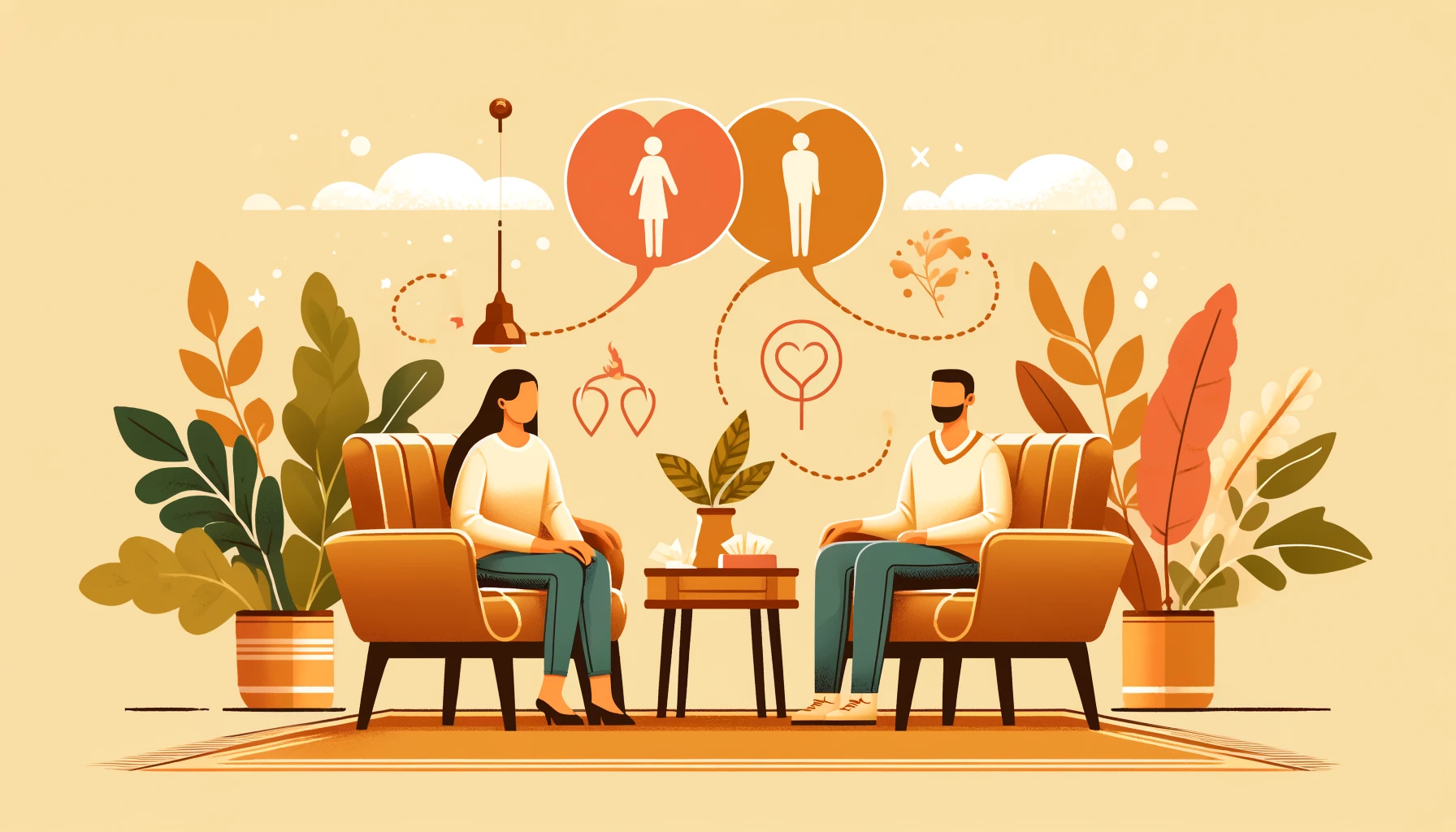Enhancing Couples Communication through EAP Services, Relationship Therapy, and Post-Divorce Support
Relationships are a tricky business, and effective communication is often the make or break factor. The complexity of human emotions and thoughts calls for a need to understand and communicate better with our partners. One way of doing so is through psychotherapy and specifically targeted programs like Employee Assistance Programs (EAP). Let’s delve deeper into this.
Introduction
Solid communication is the cornerstone of any healthy relationship. It’s the fuel that keeps the connection thriving as it prevents misunderstandings, builds trust, and mitigates conflict. However, effective communication is not as simple as it sounds; it is a skill that needs nurturing over time, holding a mirror to the thought-provoking complexity of human emotions and thoughts. When it comes to romantic relationships, couples may require guidance and strategies to improve their communication skills. That’s exactly what this article aims to provide.
We’ll dive deep into the realms of Employee Assistance Programs (EAPs) and their role in relationship health, uncovering how these resources in the workspace can lend support to relationships. Further, we’ll explore the fascinating world of couples therapy and psychotherapy techniques, drawing insights from proven therapeutic modalities. We’ll also navigate through relationship conflict resolution, emphasizing the importance of rebuilding techniques, as well as address the aftermath of a relationship that ends in separation or divorce, focusing on the importance of professional support during such a transition. So, let’s dig in and unearth the secrets to enhanced communication within couples, for healthier and more fulfilling relationships.
EAP Services and Their Role in Relationship Health
Employee Assistance Programs (EAP) are corporate initiatives designed to enhance the wellbeing of employees, which indirectly contributes to their relationship health too. Introduced primarily to supplement mental health support at the workplace, EAP services can also arm employees with the tools necessary to navigate their personal relationships more effectively.
EAPs play a pivotal role in performing regular check-ins on the emotional health of staff members. They provide counseling services to help manage personal and work-related stressors, which can take a toll on relationships if unaddressed. These programs encourage open dialogue about personal issues and facilitate the provision of guidance towards the resolution of these challenges. By assisting employees to deal with their personal hurdles, EAPs indirectly contribute to their relationship stability by reducing triggers of discontent and conflict.
The more comprehensive EAP services go beyond just counseling – they incorporate wellness programs, stress management techniques, and life coaching. They can enlighten participants on how to handle their emotions better, thus preventing emotional overflow from seeping into personal relationships. EAPs also offer tools for conflict resolution, a vital skillset in maintaining healthy relationships.
Looking at Relationary, we can see a clear example of how EAP impacts relationship health positively. Their EAPs aren’t simply a benefit – they are a lifeline extending support to employees undergoing relationship challenges. Their emphasis on equipping individuals with the tools to communicate more effectively in their relationships plays a significant role in revitalizing and strengthening them.
Research has indicated a significant correlation between proactive relationship maintenance and happiness at work. This ties directly back to the goal of EAP services — to nurture a happy, productive workforce. When employees have less personal stress, their job satisfaction and productivity increase, leading to a healthier work environment.
In summary, EAP services are an invaluable asset in the corporate toolbox, championing and promoting not just mental health but relationship health as well.
Art of Therapeutic Communication: Couple Counseling and Psychotherapy Techniques
Healthy and effective communication between partners is more an art than a science, bringing together a mix of patience, empathy, understanding, and, most importantly, active listening. Therapeutic interventions like couple counseling and psychotherapy bring this art to the surface and cultivate it into a potent tool for healing and growth.
One of the primary therapeutic models employed for relationship health is cognitive-behavioral couple therapy (CBCT). CBCT has its roots in cognitive-behavioral therapy (CBT), a form of therapy that seeks to change patterns of thinking or behavior that are harmful or ineffective. When it comes to couples, this model focuses on fostering better communication and interpersonal behaviors. It assists couples in identifying destructive thought patterns and behaviors that often lead to relational problems and provides tools to rectify these issues effectively.
Another therapeutic approach that has shown tremendous benefits is Emotionally Focused Therapy (EFT). EFT is based on the premise that emotions are integral to identity and a key factor in relationship patterns. By helping couples understand and recategorize their emotional responses, couples can work towards the creation of secure bonds and healthier interactions.
A critical aspect of all these therapies is the role of active listening. Active listening is not just about hearing what your partner says; it’s about truly understanding their needs, fears, and desires. It involves tuning in with all your senses into what your partner is communicating, both verbally and non-verbally. Masters of active listening foster environments where their partners feel seen, heard, and validated.
Then, there’s the concept of Nonviolent Communication (NVC). NVC encourages individuals to communicate their needs transparently and empathetically, fostering compassion and understanding even during disagreements or conflicts. By clarifying what we are observing, feeling, needing, and requesting, we can minimize misunderstandings and build deeper connections.
Psychology Today confirms that these therapeutic techniques, when employed effectively by a skilled professional, can have a transformative impact on relationships. By providing couples with a safe space to express themselves without the fear of judgment or criticism, these therapies can significantly boost the overall quality of communication, leading to healthier and more rewarding relationships. The art of communication, therefore, becomes a cornerstone for any successful relationship, cultivated and nurtured through therapy’s tools and techniques.
Navigating Relationship Challenges: Relationship Conflict Resolution and Rebuilding
Every relationship experiences its fair share of bumps. Whether they stem from minor disagreements or major rifts, these conflicts simply reflect the varied perspectives that each individual brings to the relationship. It’s not the presence of these challenges that spells doom for a relationship but the inability to communicate and navigate through them effectively. Therefore, relationship counseling techniques and conflict resolution tools play a pivotal role in preserving relational health.
The first step in conflict resolution is acknowledging the unrest—you can’t mend what you don’t recognize. This requires open communication and a willingness to accept one’s own faults as well as the other person’s narrative. The next phase is understanding. Now, this doesn’t mean you need to agree with your partner’s viewpoint. Rather, it’s about validating their emotions and feelings—simply affirming that their experiences and feelings are valid, regardless of your personal perspective.
Once the groundwork of recognition and understanding has been laid, it’s time to bring in problem-solving techniques. Both partners need to engage in constructive discussions about the issue, each expressing their needs and proposing possible solutions. The goal here isn’t to win or lose, but to find a joint solution that honours and respects the individual needs of both parties.
Conflict resolution is one aspect of navigating relationship challenges. There’s also rebuilding to consider for when relationships undergo seismic shifts, suffering blows that leave them fragile and shaky. Rebuilding involves taking a critical look at the relationship, pinpointing the areas that require extra attention, and thoroughly addressing these issues. At times, this may mean revisiting painful incidents and working through residual hurt.
Rebuilding also calls for crafting a relationship vision—together. Being clear about what both partners want from their relationship can foster alignment, leaving less room for misunderstandings. These aren’t always comfortable conversations, but they are crucial to rebuilding and redesigning a relationship that both parties find satisfying and meaningful.
Navigating relationship challenges is an ongoing process. But with the right tools, a dose of patience, and a sprinkle of kindness, couples can strengthen their connection, transforming their challenges into opportunities for growth and enhancement.
The Aftermath: Post-Divorce Counseling and Support
Moving on to life after a romantic relationship ends is a multifaceted, emotionally draining process. For instances when a couple decides to unchain the knot of marriage and get a divorce, post-divorce counseling and mental health support are a boon. They serve as guiding lights to navigate the tumultuous waves of the “aftermath”.
Divorce is more than a legal process; it is a humanistic life-altering event that can breed feelings of loss, fear, anxiety, and even relief. No one can truly anticipate the emotional, mental, and sometimes even physical impact it can have on them until they’re standing in the aftermath of it. And contrary to popular belief, its effects aren’t limited to the couple alone. It can ripple out to affect family, children, friendships, and more.
Post-divorce support, which often comes in the form of therapy, can be a lifeline in these uncertain waters. It provides a secure environment for expressing emotions, sorting through life changes, and setting goals for future relationships. It aids in healing the wounds of the past and reshaping the future positively.
For example, there has been a substantial upswing in “gray divorces” – a term coined to describe divorces occurring later in life when the couple is over 50. As per the insights given on Gottman’s blog, gray divorces present their own unique set of challenges – financial security after retirement, loneliness, and coping without a lifelong partner. It is here where professional help can play a significant role.
Mental health professionals can provide valuable guidance concerning financial worries, help foster social connections and provide a safe arena to voice more intimate fears and concerns that may be harder to share with friends and family.
Post-divorce support, albeit a daunting journey, is an essential step towards healing, growing, and potentially even rekindling love, in time. If we acknowledge divorce not as an end but a new phase of life, its aftermath need not be a burden. With the right professional support, it can become a journey of self-discovery, resilience, and strength. So, don’t hesitate to reach for that helping hand, for it might just light the way to a brighter, hopeful tomorrow.
Conclusion
Cultivating healthier and more effective communication with our partners can sometimes feel like a Herculean task. The road is often laden with misunderstanding and conflict, but it’s also one of endless learning, growth, and opportunities for deeper connection. This journey may require external support in the form of Employee Assistance Programs (EAP), relationship therapy, or post-divorce counseling,
EAP Services, available at many workplaces, not only emphasizes the significance of sound mental health but also plays an essential part in relationships health. It offers employees a platform to address their relationship concerns in a safe, professional environment, ultimately contributing to healthier navigation of personal relationships.
Psychotherapy techniques, like cognitive-behavioral couple therapy and emotionally focused therapy, can equip couples with crucial skills such as active listening and non-violent communication. Additionally, professional guidance can illuminate the path to conflict resolution, rebuilding relationships, or even navigating the rough waters post-divorce.
Divorce can indeed be painful, especially for couples going through a ‘gray divorce’ in their later years. However, with professional post-divorce support, it can also be a period of profound personal growth and new beginnings.
The communication challenges of relationships are not a solitary combat sport but one where we can willingly seek support, guidance, and therapy. The goal is not to avoid disagreements or disappointments but to learn how to engage with them in a way that deepens intimacy rather than creating divisions.
We can always enhance our skills to better understand our partners, express our needs and feelings, and genuinely hear what our significant other is trying to communicate. And in doing so, we may very well find ourselves in a relationship that’s more fulfilling and love-filled than we could have ever imagined.





0 Comments